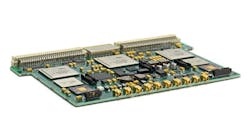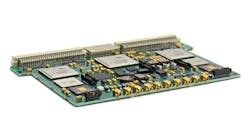Visitors to Mercury Systems’ exhibition booth (Booth #111) had a chance to see numerous examples of the company’s design innovation and assembly skills in creating highly integrated modules with multiple RF/microwave and digital functions. Modules include standard subsystems and components such as digital RF memories (DRFMs), digitizers, and field programmable gate arrays (FPGAs), as well as custom units that pack switches, amplifiers, attenuators, filters, and digital control circuitry into compact coaxial packages.
As evidence of the company’s expertise in integration, it recently received a $2 million follow-on order from a leading defense contractor for GPS filter/amplifiers for a munitions application. Charlie Leader, vice president and general manager of Mercury’s Advanced Microelectronics Solutions group, commented: “Receiving this significant order from our valued customer further reinforces Mercury’s market-leading position as a trusted supplier of high-performance radio frequency, microwave, and millimeter wave components and subassemblies supporting our nation’s military forces.”
This DRFM is one example of the high level of integration of RF/microwave and digital functions achieved in many of Mercury Systems’ board-level designs. (Courtesy of Mercury Systems)
Those seeking the secrets to achieving RF/digital integration had the opportunity to listen to the company’s chief technologist, Lorne Graves, offered a workshop entitled “Highly Integrated RF and Digital Architectures: Challenges, Benefits, and Acceptance” (today in Room 109 at 1:50 p.m.), which addressed the growing number of applications requiring highly integrated RF and digital functions, including low-power sensors for Internet of Things (IoT), commercial communications, and military systems such as unmanned aerial vehicles (UAVs).
The workshop covered the process of achieving miniaturization through the use of chip-on-board manufacturing techniques, and how such components as data converts, RF filters, and digital signal processors (DSPs) can be combined on compact circuit boards while maintaining high isolation between the different function blocks and excellent signal integrity (SI). The choice of a software defined radio (SDR) as a design example of a miniature, highly integrated RF and digital system was appreciated by those in attendance, since many were grappling with the challenges of modern wireless communications systems in commercial and military applications and finding SDRs as practical and flexible solutions for challenging wireless communications problems.
About the Author
Jack Browne
Technical Contributor
Jack Browne, Technical Contributor, has worked in technical publishing for over 30 years. He managed the content and production of three technical journals while at the American Institute of Physics, including Medical Physics and the Journal of Vacuum Science & Technology. He has been a Publisher and Editor for Penton Media, started the firm’s Wireless Symposium & Exhibition trade show in 1993, and currently serves as Technical Contributor for that company's Microwaves & RF magazine. Browne, who holds a BS in Mathematics from City College of New York and BA degrees in English and Philosophy from Fordham University, is a member of the IEEE.


